In today's extremely high-priced used car market, many shoppers are looking for "older" models that have aged well as a way to save significant dollars.
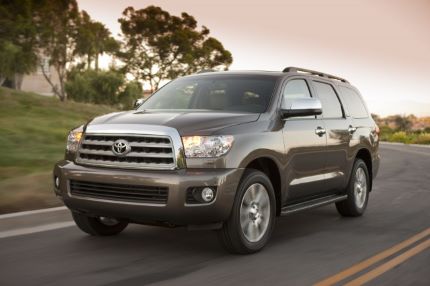
With its strong reputation for reliability, the Toyota Sequoia is certainly one of these models, making them a viable and definitely more economical option at this time. But with reliability and durability being so crucial in older vehicles, careful shopping is required.
And by older, I'm generally referring to Sequoias that are 10+ years old, which would mean those from its first and second generations, produced for the 2001 - 2021 model years, with a primary focus on the earlier models when it comes to the second generation (2008 - 2021).
With its strong Toyota genes, history has proven that a well-maintained older Sequoia can last in the 250,000 miles range, with reports of 300,000 miles and more not particularly uncommon. Of course, a key ingredient is the "well-maintained" part ... and those are the vehicles to locate.
And all vehicles have some issues, even Sequoias, that potential buyers need to be aware of before buying. While the problems may not be widespread, they certainly have happened and therefore need to be included in a pre-purchase inspection.
So here, ...
- We'll do an overview of the two first Toyota Sequoia generations, generally covering the 2001 - 2021 model years, with an emphasis on the earlier models when discussing the second generation.
- Then we'll list possible mechanical issues for these production runs that some owners have reported so they can be checked before buying one today.
- And then we'll summarize the overall pros and cons of an older Sequoia worth consideration for potential buyers.
Second Generation Toyota Sequoia (2008 - 2021)
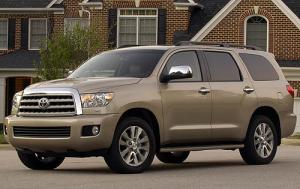
If it's a full-size SUV you're looking for, it's hard to overlook the Sequoia. The ride quality is smooth, easy and quiet ... and this SUV is a lot more maneuverable than one would expect.
Acceleration is impressive for such a large vehicle, there's plenty of amenities, and interior space is a big, big plus ... whether needed just for comfort or to move people or things.
Both earlier generations are equipped with powerful V8 engines and come in both two-wheel or four-wheel drive forms. The 2nd generation model is the larger of the two, making it a true full-size SUV.
Three trims are available in these model years: SR5, Limited, and Platinum. And in terms of features, even the base SR5 model is well-equipped, with standard equipment that includes full power accessories, triple-zone automatic climate control, alloy wheels, a 40/20/40 second-row bench seat, and a CD stereo with an auxiliary audio jack.
The Toyota Limited model adds Bluetooth, an upgraded JBL sound system, a leather interior, and power front seats.
The top-of-the-line Sequoia Platinum adds a number of upscale amenities such as 20-inch wheels, second-row captain's chairs (this reduces passenger capacity to seven), a power lift gate, adaptive shock absorbers, load-leveling rear air springs, and a navigation system with a back-up camera.
Some Sequoia models can also be found with the Platinum's features as most were available as options on the other models, as is a towing preparation package and a rear entertainment system.
Under the hood of the Sequoia SR5 is a smooth and powerful 4.7-liter V8 engine that produces 276 horsepower and 314 pound-feet of torque. It's mated with a five-speed automatic transmission.
You May Also Like:
All About Wholesale Car Prices
Powering all other Sequoias, and optional on the SR5, is a prodigous 5.7-liter V8 that's rated at 381 horsepower and 401 lb-ft of torque and is coupled with a six-speed automatic.
Unlike the first Sequoia generation, this version has an independent rear suspension that allows for the third-row seat to fold flat into the floor to create a substantial 120 cubic feet of cargo space.
It should be noted that the 2009 model added E85 flex-fuel capability on the 5.7-liter engine, but only in certain states. And the following year, the 4.7-liter base V8 was replaced with a 4.6-liter V8 engine. In 2013, the smaller V8 engine was dropped altogether, while the 5.7-liter V8 became standard on all models.
Other updates included a USB port for iPod and smartphone integration in 2010, Toyota's Entune infotainment system was introduced for 2012, plus blind-spot monitoring on the Platinum, which also got standard navigation.
In 2014, a Blu-Ray rear entertainment system became standard on the Platinum and an option on the Limited.
And the Sequoia got a refresh for 2018, including standard LED headlights, fog lights, and running lights, trim-specific grilles, updated instrument gauges, and standard driver assistance features, including adaptive cruise control and automatic emergency braking.
2018 also saw a new TRD Sport trim, which included a unique exterior trim, 20-inch black alloy wheels, restyled LED headlights, a revised suspension, and a digital display screen in the instrument panel.
2008 - 2021 Toyota Sequoia Possible Mechanical Problems
While having a solid reputation for reliability, and also generally improving on the first generation, like any vehicle, there have been mechanical issues reported by some owners which should therefore be included in an inspection before buying one today:
Lower Ball Joint Problems: This was a significant issue, especially in the earlier models of the second generation, leading to a recall campaign by Toyota.
Rusty Frame: The frames were prone to rust, which was attributed to insufficient anti-corrosion treatment.
Leaking Camshaft Towers: This problem could cause oil leaks and potential engine damage.
Oxygen Sensor Failure: Faulty oxygen sensors could lead to engine performance issues and trigger the check engine light.
Brake System Problems: Issues with the brake system, such as premature wear of brake pads and rotors or malfunctioning ABS modules, were reported by some owners.
Timing Belt Tensioner and Water Pump: Like the first generation, early model's timing belt tensioners and water pumps were reported to fail by some owners.
Transmission Problems: Some owners reported transmission issues, including rough shifting, hesitation, or slipping gears. These problems could be attributed to issues with the transmission fluid, solenoids, or internal components.
Excessive Oil Consumption: Some models were reported to consume excessive amounts of engine oil between oil changes. This could be caused by worn piston rings, valve stem seals, or other internal engine components.
Air Suspension Issues: For models equipped with optional air suspension systems, problems with air springs, air lines, or the compressor were reported. This could lead to uneven ride height, sagging suspension, or suspension fault warnings.
Steering Rack Leaks: Similar to the first generation, leaks from the power steering rack were reported in some second generation Sequoias.
Electrical Gremlins: Various electrical issues were reported by some owners, including malfunctioning power windows, door locks, audio systems, and dashboard instrument clusters. These problems could be caused by faulty wiring, connectors, or electronic modules.
Suspension Noise: Some owners reported noises from the suspension, such as clunks, rattles, or squeaks. These noises could be caused by worn suspension bushings, ball joints, or shock absorbers.
Cooling System Problems: Issues with the cooling system, such as leaks from the radiator, hoses, or water pump, were reported by some owners.
Exhaust System Leaks: Cracks or leaks in the exhaust system, including the exhaust manifold, catalytic converters, or muffler, were reported by some owners.
It should be noted that most Sequoias did not experience these problems.
First Generation Toyota Sequoia (2001 - 2007)
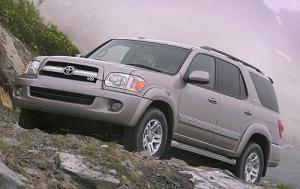
This version is an eight-passenger SUV that was initially outfitted with a 240 horsepower 4.7-liter V8 mated to a four-speed automatic transmission. This generation offered two models, the SR5 and Limited, both offered in either two or four-wheel drive forms.
The base SR5 models were very well-equipped with features such as power windows, mirrors and door locks, cruise control, automatic climate control, and an AM/FM stereo with both cassette and CD players.
The Limited added leather seating, power retractable exterior mirrors, dual air conditioning, heated seats, a ten-speaker JBL sound system, and aluminum wheels. It also included third-row seating, privacy glass, a roof rack, and a tow hitch.
Of note to potential older Sequoia buyers are several significant changes that took place throughout this run. In 2005, power was boosted to 282 horses (later revised to 273 due to a changed rating method) and 325 lb-ft of torque in the 4.7-liter V8. A new five-speed automatic transmission was also introduced.
The 2005 Sequoia also got an exterior design refresh as well as two popular new options packages: the SR5's sport package and the Limited's luxury package. Both of these included a height-adjustable rear suspension.
And in 2007, front-seat side airbags and side curtain airbags were made standard in all models.
2001 - 2007 Toyota Sequoia Possible Mechanical Problems
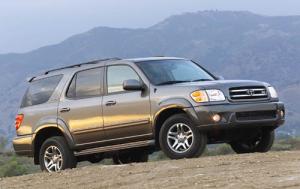
While the first generation Sequoia generally earned a good reputation for reliability, like any vehicle, it was not without mechanical issues reported by some owners, which should therefore be included in a pre-purchase inspection:
Front Ball Joint Failure: Ball joints were prone to shearing off, leading to potential control issues while driving.
Cracked Exhaust Manifold: This issue would often manifest as an engine ticking noise that might disappear once the engine warmed up.
Oxygen Sensor Failure: Faulty O2 sensors could trigger the check engine light and affect the vehicle’s performance.
Premature Front Brake Wear: The brake calipers, known for seizing, especially in inclement weather, could cause the front brakes to wear out quickly.
Yaw Rate and Deceleration Sensor Failure: Failure of these sensors could result in the ABS or VSC light turning on, potentially affecting the vehicle’s stability control system.
Rear Differential Failure: Some owners reported issues with the rear differential, including leaks and premature wear. This could lead to noise, vibration, or loss of power to the rear wheels.
Timing Belt Tensioner Failure: Some owners of early models of the first generation reported timing belt tensioner failure, which could lead to timing belt slippage or breakage, resulting in severe engine damage.
Transmission Problems: Some owners experienced transmission issues, such as rough shifting, slipping gears, or premature failure. This was more common in models equipped with the 5-speed automatic transmission.
Steering Rack Leaks: Leaks from the power steering rack were reported in some Sequoias, leading to a loss of power steering assistance and potential fluid leakage.
Air Suspension Failure: Models equipped with optional air suspension systems could experience failures in the air springs, air lines, or compressor, leading to suspension sagging, uneven ride height, or suspension system fault warnings.
Electrical Issues: Various electrical problems were reported by some owners, including malfunctioning power windows, door locks, audio systems, and dashboard instrument clusters.
It's important to note that not all Sequoia vehicles experienced these issues, and many owners enjoyed trouble-free ownership for many years.
Overall Pros And Cons Of An Older Toyota Sequoia
Older Toyota Sequoia Pros
Reliability: Built on Toyota's reputation for durability, older Sequoias are known for their long-term reliability and low incidence of major mechanical issues.
Affordability: Obviously, older Sequoia models can often be found at a lower price and therefore save significantly on upfront costs.
Resale Value: Older Sequoias can still retain decent resale value, particularly if well-maintained and in good condition, potentially reducing the overall cost of ownership over time.
Off-Road Capability: Models equipped with four-wheel drive can handle mild off-road trails and rough terrain, providing versatility for outdoor enthusiasts.
Aftermarket Support: There's a wide range of aftermarket parts and accessories available, allowing owners to customize and enhance their vehicles according to their preferences and needs.
V8 Engine Power: Equipped with a potent V8 engine, the Sequoia offers ample power for towing, hauling, and highway cruising, providing a smooth and confident driving experience.
Interior Comfort: With a spacious and well-appointed cabin, the Sequoia offers comfortable seating for up to eight passengers, making it suitable for long road trips or family outings.
Safety Features: While lacking some of the latest advanced safety technologies, an older Sequoia still comes equipped with standard safety features such as airbags, stability control, and anti-lock brakes, contributing to its overall safety.
Longevity: Many owners report high mileage and longevity with their Sequoias, with some vehicles surpassing 200,000 miles and more with proper maintenance, making it a good long-term investment.
Versatility: Whether used for daily commuting, family transportation, or outdoor adventures, the Sequoia offers versatility and adaptability to a wide range of lifestyles and activities.
Older Toyota Sequoia Cons
High Mileage: Older Sequoias may have higher mileage, which can increase the likelihood of mechanical issues and the need for costly repairs or maintenance, potentially offsetting some or all of the upfront cost savings.
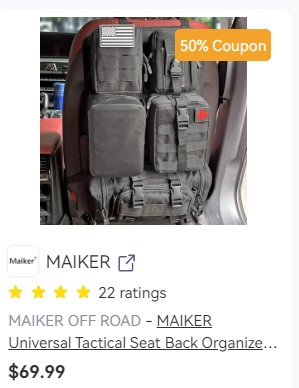
Outdated Technology: Older Sequoia models may lack many of the modern features and technologies found in newer vehicles, including advanced safety features, infotainment systems, and driver-assistance technologies.
Size and Maneuverability: The Sequoia's large size can make it difficult to maneuver in tight spaces, park in urban areas, and navigate narrow trails, limiting its practicality for some drivers.
Environmental Impact: Older Sequoias may have higher emissions and environmental impact compared to newer, more fuel-efficient vehicles, contributing to pollution and higher operating costs.
Potentially Dated Styling: The design of older Sequoias may appear dated compared to newer SUVs, lacking the sleekness and modern aesthetic of more contemporary vehicles.
Poor Fuel Economy: The Sequoia's large V8 engine and heavy curb weight contribute to poor fuel efficiency, resulting in high fuel costs for daily commuting or long-distance travel.
Interior Material Quality: While spacious and comfortable, the Sequoia's interior materials may not feel as upscale or luxurious as those found in some competitors, with more hard plastics and less premium finishes.
Limited Cargo Space: Despite its large size, the Sequoia's cargo capacity may be insufficient for hauling bulky items or large loads, especially with all seats in use, limiting its practicality for some buyers.
Stiff Ride Quality: The Sequoia's suspension tuning prioritizes towing and hauling capability over ride comfort, resulting in a somewhat stiff and bumpy ride, particularly on rough roads or uneven surfaces.
Slow Acceleration: Despite its powerful V8 engine, the Sequoia's acceleration may feel sluggish compared to more performance-oriented SUVs, especially when fully loaded or towing heavy trailers.
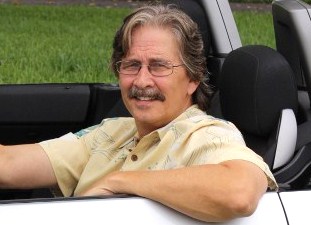 By Josh Rosenberg
By Josh Rosenberg